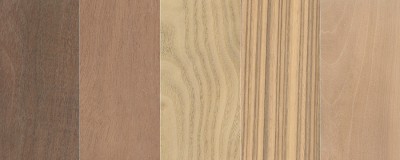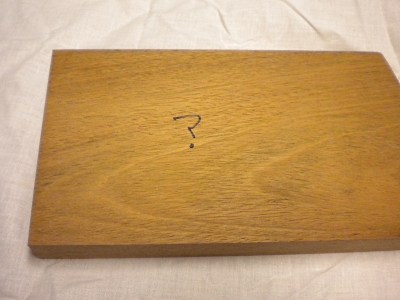After having personally worked with hundreds of wood species, (obviously some much more than others), and having read a number of books and articles on wood identification, I’ve come to an unsettling conclusion: it seems that the more I learn and discover, the more I realize how very little I know. The more accurate and thorough my identification process becomes, the more certain I become that I really cannot guarantee that I am correct.
Think you’re a know-it-all? Take this test to see how good you really are!
Hypothetical situation:
A wood-collecting friend approaches you with five different wood samples, and asks you to identify them. You ask them where they came from, and they just shrug their shoulders and hand you the samples. You have nothing to go on except the facegrain of the wood itself. This is what you see:

So, what are your guesses? Well, if you had deduced any of the woods that I initially guessed, then you’d get a score of zero! Here are the actual identities of the woods above, from left to right:My Guesses:
- Black walnut – Color and grain look right, and it’s a common hardwood, so it’s a solid guess; weight is a bit high: is this board still drying?
- Honduran mahogany – Grain might be a little plain, but the pattern looks right, and the weight feels close.
- White ash – The color and coarse grain looks like ash, though the weight seems a bit too light: maybe the sample is from a very dry location?
- Zebrawood – What other wood has this kind of zebra striping? Most likely quartersawn since the stripes are so uniform.
- Black cherry – Color and grain are similar, and the weight feels right-on, eliminating heavier fruitwoods like apple.
Do you see how my ability to accurately identify wood based upon intuition was tainted by my own experiences of what I thought were “regular” woods? I named woods that I was used to working with, but for different people, in different parts of the world, this set of intuitive guesses might be totally different. A person in China or Australia might have five totally different guesses than mine, and all could be completely wrong guesses, with each person equally self-assured and unable to sufficiently articulate their position.Correct Answers:
- Black mesquite – A fair amount heavier than walnut, also diffuse porous with vasicentric to aliform parenchyma.
- Andiroba – Well, it’s brown… does that help? There are a bunch of Mahogany lookalikes: it’s not always easy to tell them apart.
- Sassafras – Very similar in appearance to ash, but slightly lighter in weight, and with a spicy odor.
- Beli – Zebrawood isn’t the only wood that is striped. Beli has heavily vasicentric parenchyma, while Zebrawood’s parenchyma tends to be diffuse-in-aggregates.
- Sourwood – Not only was it not Cherry, it wasn’t even in the fruitwood/rose (Rosaceae) family!
The truth is, it’s a crapshoot
Probably the most common means of identifying wood among woodworkers is to simply eyeball the facegrain of the wood sample, and allow some sort of unspoken instinct or imperceptible intuition to just pop into their heads with the right answer. Using this quasi-magic “second-nature” method to accurately identify wood down to a genus and species level is not only unscientific, unhelpful, and unteachable, it’s a crapshoot.
Great expectations
This limitation usually isn’t in the methods or means of identification, but in the wood itself. In botany, a tree species is not classified and described by its wood, but rather, by its leaves, bark, flowers, seeds, fruit, etc. Oftentimes, there are just not enough uniquely identifying characteristics present in the wood of each species to clearly and authoritatively differentiate it from another—not even when viewed under a microscope.
Furthermore, trees occur throughout a variety of natural environments, so the wood exhibits a surprising amount of variability. This is part of what makes woodworking so enjoyable: no two boards are quite the same; but this same variation can also frustrate many identification procedures, and confuse us by the apparent lack of consistency.
The problem is mostly with our expectations: we want to know exactly what kind of wood that we have. We expect just by examining it, that there is some indescribable way of deciphering down to the species level what type of wood is set before us. Sure, we might be able to narrow a sample down to maple, and tell that it is from the Acer genus, but that’s not enough: we want to come up with something like Acer pseudoplatanus. In the majority of cases, that level of precision is just not possible.
But further compounding the problem is that some of the most useful information is contained in a clear and magnified view of the endgrain. Simply viewing the facegrain of a wood sample with the naked eye puts an even greater limitation on our ability to identify it accurately.
One of the worst things that we can do is arrogantly convince ourselves that we can indeed tell one species apart from another when, given the available data, we simply cannot. If we just go by intuition and take an unsubstantiated guess, we’ll quite likely guess wrong.
Fill in the blank, or multiple choice?
Of course, if we had restricted this exercise only to the most commonly used hardwoods, then the identification process would’ve been much easier. But in real-world situations, it’s seldom that simple. It’s one thing to find a misplaced board at a lumberyard and reason, “this must belong in one of these piles” and have our expansive quest reduced to a simple multiple-choice test question.

Or suppose that we were at an Amish furniture shop in Pennsylvania, and we knew that they mill and process all their own timber: the choices would be significantly narrower, and the source of the lumber would be more obvious. We would logically deduce that the wood had to originate from a region nearby, and must be limited to only those trees that are native to the northeastern United States. This is what we call provenance: when we know with a fair degree of certainty where a wood sample came from.
A difficulty for us amateur wood detectives (in addition to the absence of unique identifiers already lacking in the wood itself), is that we usually have little to no information about the origin of the wood. The wood just showed up from somewhere: it was pulled from someone’s dusty garage shelf, or it was taken from an obscure pallet or crate, or it was discovered second-hand at a garage sale. While certain woods are certainly much more common than others, this lack of a reliable source leaves the door wide open to the big, broad, vast expanse of this tree-covered globe. Our number of choices—even among commercially viable timber-producing trees—is staggering, to say the least. We are essentially being asked to fill in the blank. Even a printed volume that encompasses several hundred commercial (and many non-commercial) wood samples would be insufficient to address each and every possible wood species that is and has been in use.
When wood identification works
Of course, there are certainly times when wood identification is very useful and reliable. While there are typically not enough unique characteristics to identify a particular species (i.e., Acer pseudoplatanus), oftentimes—especially with many temperate-zone hardwoods found in the United States—there will be enough information present to reasonably identify a sample down to the genus level (i.e., Acer spp.). We may not be able to take a wood sample and pronounce, “this is Quercus laurifolia—Laurel Oak.” But we should be able to identify that it is in fact an oak, in the Quercus genus. And from there, we may even be able to identify it down to a sub-genus level, and say it is in the red oak group.
But another advantage in wood identification lies in the fact that even though it seems we have no clues to go on, we can usually make some safe assumptions or inferences about a wood sample’s provenance.
For instance, if we see some wooden kitchen cabinets out in a rustic country cabin, it would be reasonable to assume that most cabinet-makers in the area would’ve used a domestic hardwood species. There are only perhaps a few dozen native hardwoods commonly used for cabinetry in the United States, which narrows our options down significantly. In this instance, if we have much experience in domestic hardwoods at all, we should be able to eyeball and/or spot the differences between maple, beech, oak, walnut, etc. relatively easily. (Further examination might then confirm or deny our initial designation.)
But if we were in a fancy, upscale city restaurant where all the woodwork looked foreign and unfamiliar, or we were in a distant locale such as South Africa or Thailand, then the story would be much different, and a much different set of assumptions—perhaps a set unknown to us—would have to be used. (For more information on these types of deductive identification methods, please see the page entitled Wood Identification Guide.)
Be honest
We might as well be honest with ourselves: sometimes wood identification is an uncertain thing. So long as we maintain proper expectations of the identification procedure, and recognize that we might not have all the answers, wood identification can be a useful and enjoyable pursuit. Sometimes the most accurate answer that we can expect to uncover through diligent and thorough examination is simply a question mark.

Get the hard copy





Can you help me identify this would please I’m new to woodworking and I have no idea species of wood I can only tell softwood from hardwood
I’m looking to ID the wood of 2 objects, dose anyone do age testing? Both pieces are pretty old, one is a totem pole , the other has been in the ocean for a good long time, I believe was part of an old ship.
I hope this wood is easy to identify. It has the three letters of BLM on it, but I can’t ascertain what BLM stands for. I’m very new to using exotic woods. Purchased this as a lot of many different species a while back and the seller didn’t know. I asked my lumber supplier, and he offered the very obvious answer to BLM, but it does not ID the wood he didn’t know. I appreciate your time.
I’ll guess it’s black limba.
Thank you. I believe you’re correct. After checking the Wood Database everything listed matches. I have never heard of it, but again, I am new to exotic woods. Now I have to find a project for it.
I have lived in Hawaii for 50 years, doing woodworking for maybe last 15 or so. I was visiting my daughter on the east coast, Connecticut area. Flew out of the airport in Massachusetts. On my way to the gate I stopped at a little sales kiosk which had some wooden pens. I saw one with a beautiful red/brown/gold luster to it and wracked my brain trying to figure which east coast wood this could be made from, to no avail. I finally asked the salesperson and she said it was Koa from Hawaii. I have dozens of pieces of… Read more »
I was chopping up some scrap wood with my father and there were logs of this mystery wood, this is a cross section of one of the medium sized logs. Most of the logs aren’t that big. When scratching it with my finger nail, it left a mark, but that may be because it still has some moisture. This is from the US, more specifically, New York. Could you Identify it? Thanks.
Ivory possibly
Identify my floors please
Looks like a softwood of some sort, possibly pine.
Please what is the name of this wood from West Africa? Is this Ozouga or Rikio or some other wood?
I took and dendrology class in college and one of our tests was to identify tree species by looking at the xylem and phloem under a microscope.
anyone know what kind of wood this is?
I still can’t figure it out it’s a Hardwood but when you sand it Sands like cedar doesn’t smell like Cedar. Can anybody identify it for me?
It looks vaguely like black cherry. Can’t make out enough details from the pic.
I bought a piece of Brazilian Kingwood on ebay, or I’m pretty sure that’s what I bought. Sometimes we simply have to trust the seller but to be honest, I don’t see how this wood could be anything else. Makes me wonder, though.
that doesn’t look like Brazilian kingwood but more like Bocote which is a member of the Cordia Genus rather than a dalbergia which are true rosewoods
Hi, Eric, I’m just start falling in love to the wood furniture realised the texture of the woodgrain are totally unique and rare for me. But, was wondering of my piece wood collection, do u have any thought about this type of wood. It’s quite heavy, look like 3d texture after sand, texture with swirel and bit wavy patterns. Really appreciate your help
Where are you located? It doesn’t look like any common hardwood used in temperate North America.
I’m from Malaysia, the unique of this piece is, the twin grain circle. Looks like symbolic number 8.
But still wonder, what is the type of wood. This piece weight about 3.6kg
Sorry, I am not very familiar with native woods of Malaysia, so I can’t ID it. It may be something more obscure to North America that’s not yet on the site.
Hi. Wondering if you have thoughts on this piece of furniture. It’s been stripped and sanded. The side that is darker is only because it’s been wiped with mineral spirits to bring out the grain. It’s origins are Europe and it is very hard (made the saw smoke)! Thanks
From all those rays, it looks most like oak to me. That dark piece may be brown oak, which isn’t really seen over here in North America, but may be more common where you’re from.
and here the last
here two other pieces of furniture
What do you think these two pieces could be?
First one looks like white oak, second appears to be a softwood species of some sort. Would need to get a closer and clear shot of the endgrain to look for resin canals.
Here two furniture
Looks to be a softwood species of some sort. Would need to get a close and clear shot of the endgrain to check for resin canals.
Pictures attached as don’t think it worked on original post!
I agree that it’s not pine. There are very contrasted areas of the darker heartwood along with the lighter sapwood. The most likely candidate where this sort of combination is used would be teak. That’s my leading guess, though it could possibly be some other imported hardwood.
Thank you Eric, next week we are going to sand it properly. It looked like it had been varnished so we have tried to take that off with a light sand. We have bought a belt sander so hopefully that will bring out the lovely colours in the table. We did wonder if it might be hickory with the white being in it ? but if teak that’s is good too.
We where hoping to use it as an outdoor table hope it’s not too good for that?
Thanks again
Mandy
Hi, bought a second hand table they said it was pine but when we collected it it’s no way pine it’s so heavy. Can you identify it please as we are going to rub it down and want to know what to treat it with. I think it might be hardwood of some sort? Pictures attached
bought some clearance wood from Woodcraft and there are several that i have no idea what they are.
i can’t find a wood that seems to have a light heartwood and dark sapwood
after cutting a fresh end, i sanded it w 600 grit.
in U.V. light, it has strange reddish lines that follow the grain
bought some clearance wood from Woodcraft and there are several that i have no idea what they are.
after cutting a fresh end, i sanded it w 600 grit.
Looks a bit like Iroko to me, but can’t be certain
bought some clearance wood from Woodcraft and there are several that i have no idea what they are.
after cutting a fresh end, i sanded it w 600 grit. it created an odd medium-light orange dust on the sanding disk.
Hello! I picked up a cabinet at a golf course auction here in Ohio that I’m planning on refinishing as well as building some new doors for it. I’m having a time determining what kind of wood this is. The outside of the cabinet is finished, but the inside & underside is completely unfinished. I’ve attached pictures of both outside and inside for review. I’ve also attached some pictures of the endgrain before sanding, after sanding, wiped with alcohol and zoomed. Any help would be greatly appreciated! FYI: Due to the size and quantity limit if the pictures, I’ll post… Read more »
Additional pictures.
Looks like black walnut.
I was leaning towards black walnut too. Just needed some confirmation. Thank you!
Exterior pictures.
I am curious to identify the wood used to make this clock for my father, in Australia, in the 1990’s
It looks like a burl slab to me.I live in Australia, and we really don’t have that many deep red coloured timbers that produce burls like that. If it was made in eastern Australia then it is likely to be river red gum. If it was made in Western Australia, then it could be jarrah.
We had a considerable amount of trees come down on our property over the past few years, and this year my wife and I invested in a portable sawmill and milled up the boards. The trees, as identified by the bark as well as in some cases knowing what the tree was in years prior while it was still alive from the leaves, were red oak, beech, hickory, poplar, and ash. Fast forward to a few days ago, I asked guys doing work on my property to relocate the slabs so that they could be out of the way while… Read more »
Short answer is: if you can get info of trees rather than wood, that’s nearly always best. But assuming the trees aren’t anything too obscure and are normal hardwood species common to North America, you should have a good chance at ID’ing them. Down to a species level, usually not.
Hi Eric. Thanks for an amazing web resource… I’m amazed by the timber variety you’re collating. My comment is actually a question – but also an invitation for you to compile a whole new parallel website when you’re bored (!) – how to identify wood used in antique furniture… Here are some photos of the timber of a very old London tall case clock. As is very common, it has had quite a life – bits badly repaired, patches just glued on, and in this instance I suspect also stained/painted. But here’s the interesting bit. The colour and even look… Read more »
Can you try to reattach pictures? They didn’t come through.
Apologies – here are three (maximum allowed) … any thoughts what timber or timbers this is made from would be really gratefully received… thanks!
It does look like similar to mahogany to me, or at least something tropical, so given its age mahogany may be most commonly used import. Some of the other frame pieces look like old growth softwood of some sort.
Thanks Eric. But the puzzle is, my research confirms there really was no mahogany imported into England in 1700… so I will probably have to accept this section, at least, is an old repair/remake…. S
Here’s a sample that the good folks or Reddit said I should present to you. Found in Zone 5 -central Iowa as a stump with thick, chunky bark. Very orange-red when raw, but color is more creamy when cut. 2+ foot diameter with no distinguishable sap wood. Thanks for any leads!
Thanks, is it possible to get a finely sanded close up picture of the endgrain? Any noticeable scent when cut? How does the wood’s weight compare to known woods?
It is lighter than a hardwood. I’ve also recently worked black walnut, Sycamore, and White Oak. It;s lighter than all of those. I’ll sand it out and take a close up soon. Thanks!
When sanding it had a slight warm or nutty scent, burned fast on a belt sander, but is lighter than many woods.
Here are shots dry, moist and close-up.
Okay, so the rays look pretty big and noticeable, so that’s a good clue. Also appears to be semi-ring-porous. To me, the most likely candidate would be a fruitwood in the Rosaceae family. Possibly Prunus species. Have you worked with black cherry lumber before, and if so, how does this compare?
Hi. I am retired and building ukuleles in my garage as a hobby. I’m currently teaching my four grandchildren how to build their own ukuleles from scratch. I’m hoping you will help identify the enclosed wood photos (facegrain dry, facegrain with distilled water, end cut). A guy on Craigslist recently sold it to me, saying that it was mahogany (which is what I wanted; actually Honduran mahogany is my preferred wood for ukulele necks). The wood is from a 45-year-old wine cellar door, including the door frame. Each piece is 2″ thick and 4.5″ wide. I cut the pieces into… Read more »
Of the initial guesses you got (meranti, khaya, makore, luan, sapele, santos mahogany) really the only one with an odor you describe is santos mahogany. A distinctive odor is something that can’t really be dismissed. One picture the wood looks almost orange, and another it’s a reddish brown, so hard to tell. Have you considered sapele or utile, two closely related species.
Thank you, Eric. I appreciate your observations. The wood is predominantly brown, with a slight reddish tinge. I’ll look closely at sapele and futile. And, yes, the scent really stands out when cut. I was very surprised to smell a strong scent given that the wood was first sawn 45+plus years ago. Again, thank you!
It might be worth checking for fluorescence too if you get the chance. https://www.wood-database.com/wood-articles/fluorescence-a-secret-weapon-in-wood-identification/
Hello,
Great article. Do you know of a service or an organization that would identify samples of wood for me? I’m in Asia and have access to many types of wood, but rarely get a correct name. Is it rosewood? Is it padouk? Bubinga? Acacia? It’s always a mystery. The Chinese have very different names for wood and rarely provide any scientific names. Confirmation or getting close would help!
Yes I’m trying to find out what kind of wood this is. ?? And can you use it for a deck ?
Need to get a closer pic of the wood